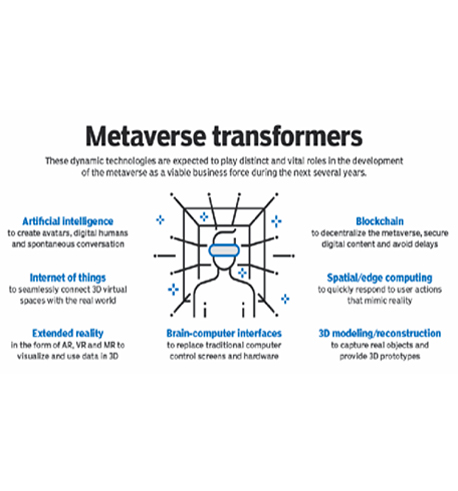What is the metaverse? A short history
The metaverse is a vision of what many in the computer industry believe is the next iteration of the internet: a single, shared, immersive, persistent, 3D virtual space where humans experience life in ways they could not in the physical world.
Some of the technologies that provide access to this virtual world, such as virtual reality (VR) headsets and augmented reality (AR) glasses, are evolving quickly; other critical components of the metaverse, such as adequate bandwidth or interoperability standards, are probably years off or might never materialize.
The concept is not new: The term metaverse was coined in 1992 by author Neal Stephenson in his sci-fi novel Snow Crash, and work on the technologies that underpin a virtual reality-based internet date back decades (see metaverse history timeline below).

How does the metaverse work?
Because the metaverse is largely unbuilt, there is little agreement on how it will work.
Broadly speaking, however, the metaverse is a digital ecosystem built on various kinds of 3D technology, real-time collaboration software and blockchain-based decentralized finance tools.
Factors such as the degree of interoperability among virtual worlds, data portability, governance and user interfaces will depend on how the metaverse pans out.
Lauren Lubetsky, senior manager at Bain & Company, speaking in a session on the metaverse at the 2022 MIT Platform Strategy Summit, outlined three possible scenarios:
How is the metaverse accessed?
Two technologies considered important to the development and growth of the metaverse are virtual reality and augmented reality:
Whether VR and AR experiences turn out to be the primary interfaces of the metaverse remains to be seen, Gartner senior principal analyst Tuong H. Nguyen told Lawton, adding that what we have now are precursors or pre-metaverse solutions.
At present, many of the metaverse-like experiences offered by gaming platforms such as Roblox, Decentraland and Minecraft can be accessed through browsers or mobile devices and a fast internet connection.

Metaverse technologies
In her article "7 top technologies for metaverse development," technology writer Esther Shein explained that industry watchers shy away from codifying the technologies that will power the metaverse. This is in part because the metaverse is evolving and partly because many of the tools driving the metaverse are themselves made up of multiple technologies.
Gartner, for example, prefers to describe metaverse technologies in terms of "tech themes." The themes include spatial computing, digital humans, shared experiences, gaming and tokenized assets. Forrester Research characterizes metaverse tools as "enablers of 3D development environments." Professionals skilled in 3D modeling and IoT for developing digital twins are among the talent companies will need to recruit for.
The consensus among Shein's expert sources was that these seven technologies will have the biggest impact on metaverse development over the next decade:
What is the Metaverse used for Today?
The online gaming industry has decades-long experience in creating immersive virtual worlds. And to the extent a proto-metaverse has a mainstream use, the massive audiences that flock -- albeit not synchronously -- to the likes of Roblox, Epic Games and Decentraland suggest that playing games, building virtual worlds and investing in real estate might be it.
Enterprises are experimenting with metaverse applications in the workplace that build on the virtual applications companies deployed during the pandemic to support remote work. An early application of metaverse technologies involves workplace training. Some hospitals are already using VR and AR to train for common medical procedures, reported TechTarget news writer Esther Ajao. One technology recently approved by the FDA is Medivis, an AR surgical system that lets surgeons quickly sync with a hospital's digital imaging system. Other metaverse-type applications she wrote about in her article, "Enterprise applications of the metaverse slow but coming," include the following:
How should businesses prepare for the metaverse?
Creating successful metaverse work environments will require far more than grafting existing office spaces and protocols onto virtual spaces, according to employment experts interviewed by technology writer Lawton. Indeed, early research suggests that simply translating existing offices into a 3D virtual equivalent can reduce productivity and even cause nausea and motion sickness.
Still, like the internet in the 1990s, the Metaverse represents an opportunity to "shrink the world," said Andrew Hawken, co-founder and CEO of Mesmerise, a VR technology vendor. Done right, the experts Lawton interviewed said, metaverse technologies could increase teleworker camaraderie, improve collaboration, speed up training, reduce the need for office space and make work a happier place in general. The metaverse will also eliminate jobs, requiring companies to reskill workers, said Frank Diana, managing partner and futurist at Tata Consultancy Services.
Metaverse pros and cons, challenges
No matter what form the metaverse takes, cybersecurity and privacy standards loom as major challenges.
As security expert Ashwin Krishnan explained in his companion articles on metaversecybersecurity challenges and privacy concerns, the current lack of privacy regulations for the metaverse presents many risks for businesses and users, including the following:
Krishnan advised that businesses should be proactive in creating a viable data privacy policy tailored to their organizations and to work with the major metaverse platform owners and standards organizations to establish security and privacy safeguards. Consumers will need to make an effort to understand the security and data privacy policies of both the businesses they frequent and the metaverse platforms on which those businesses reside.
What will the coming technology revolution mean for average user? For her article on metaverse pros and cons, technology journalist Mary K. Pratt interviewed analysts, consultants, business executives and researchers on the metaverse's potential benefits and drawbacks. On the positive side, an immersive metaverse enables humans to go where they were never able to go before, including outer space. Online social connections become much richer. Of course, the bad behavior witnessed on social platforms has the potential to be magnified in a virtual world. Findings are summed up in the chart below

